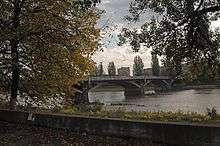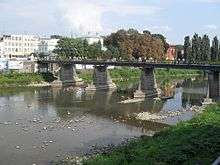Bridges in Uzhhorod
Uzhhorod, Ukraine, historically was situated on the right bank of the Uzh River, covers both banks of the river as it flows through the city. Additionally, there is a small canal that re-enters the river as it enters the city. Currently there are seven bridges spanning the river and a few more bridges across the canal.

History
The first bridges of Uzhhorod are mentioned in chronicles of 1631 and 1690 years. Until then in the Middle Ages, the Uzh River was crossed by fording or riding ferries.


The main city bridge is called Tomas Masaryk Bridge (or the Great Bridge) that was built in 1930s and today connects ploshcha Druzhby Narodiv (Friendship of Nations Square) on the right bank with ploshcha Bohdana Khmelnytskoho (Bohdan Khmelnytskyi Square) on the left bank. The construction of the bridge started in 1934 and valued 8 million Czechoslovak koruna. Measured in 140 metres (460 ft) in length, it was opened in 1937 during the visit of Czechoslovakian president Edvard Beneš to Uzhhorod. The bridge was named after Tomas Masaryk, on a decision that was adapted back in 1930. With the occupation of Uzhhorod by the Hungarian troops in 1938, the bridge was stripped of its name and was called simply as Great Bridge. That name stayed until after fall of the Soviet Union. In October 1944 the withdrawing Hungarian and German forces blown almost all the bridges in Uzhhorod into air. After the war, the Great Bridge as the others were rebuilt by Bosnian-born German Engineer Janos (Hans) Schlesinger.[1] After moving to the Soviet Union Schlesinger adopted Russian name Ivan under which he was buried.[2]
Beside the Great Bridge, Uzhhorod has another no less important bridge which connects the city's Teatralna ploshcha (Theatric Square) and ploshcha Sándora Petőfi (Sándor Petőfi Square). The bridge existed as wooden until the great city flood of 1893 which destroyed the bridge. Yet it was relatively quickly rebuilt as iron bridge in 1896-1897. In 1921 over the bridge stretched a bus route of the first city bus. The bridge also was destroyed during the World War II. It was quickly replaced by Red Army with a pontoon bridge becoming the only active road bridge in the city with another rail bridge not far up the stream. Later it was replaced with a temporary wooden bridge structure, until finally Schlesinger built the current 90 metres (300 ft) long bridge which became exclusively pedestrian and one of the city's landmarks.
 Suspended bridge between Avanhard Stadium and Bozdos Park
Suspended bridge between Avanhard Stadium and Bozdos Park The pedestrian bridge before World War II
The pedestrian bridge before World War II
References
- Literati, T. Lost Uzhhorod: life story of creator of pedestrian bridge Ivan Schlesinger (Втрачений Ужгород: історія життя творця пішохідного мосту Івана Шлезінгера). "Prozahid". 14 March 2017
- Literati, T. Lost Uzhhorod: how was rebuilt the Masaryk's Bridge (Втрачений Ужгород: як відбудовували міст Масарика). "Prozahid". 26 November 2015
External links
| Wikimedia Commons has media related to Bridges in Uzhhorod. |
- Turianytsia, Yu. Bridges of Uzhhorod: less known pages (Мости Ужгорода: маловідомі сторінки). Zakarpattia online. 7 October 2009.
- Great bridge in Uzhhorod on old postcards (photo) (Великий міст в Ужгороді на старих листівках (ФОТО)). prozak.info.